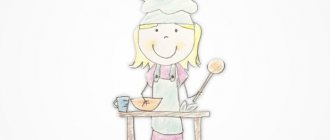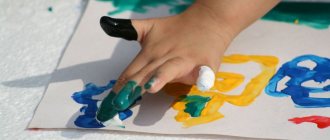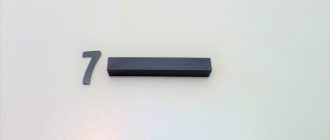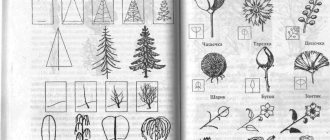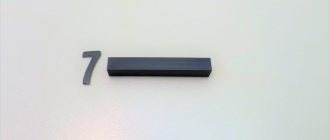We act in stages
So, geometric shapes are important for the development of children. To master them successfully, you should use the following rules.
- We begin our acquaintance with the simplest shapes (these will be a circle, a triangle and a square).
- At the initial stage, it is better that all the figures are the same color and size, so as not to distract the baby with unnecessary details.
- We remember about age (at 2 years old we master only the circle, square and triangle; by 3 years old we add an oval, rhombus, rectangle; by 4 years old - a trapezoid, star, pentagons or hexagons).
- Training should be multifaceted so that the child constantly consolidates the acquired skills (we trace the shape with our fingers, learn to find shapes around and distinguish, sort them by type, size, create and analyze applications, sculpt, cut out, play with cards or lotto, consolidate shapes in active games ).
Start studying with flat images, gradually showing your child the difference between plane and volume, teaching him to compare a three-dimensional geometric body with its flat image.
Sorting geometric shapes
The process of sorting objects began to interest my daughter at the age of 1 year 4 months. We sorted items by color, size and, of course, shape. I think Taisiya really liked this game because we often involved her toy friends in it. As soon as the doll Masha was invited to play, for example, she immediately reported that she liked to play only with triangles, and the bear said that he only liked rectangles. So we had to carefully select the figures so as not to offend anyone :)
Where to start studying?
To begin with, you can introduce your child to the image of a circle: trace it with your fingers and tell what it is. After a day, start looking around you for everything that reminds you of it. If the baby finds it difficult, parents should help him. The following figures are studied in the same way.
Then you should explain to the child that three-dimensional figures are similar to flat ones (a square is like a cube, a circle is like a ball). Let him try to correlate them, finding analogies around himself. To do this, it is useful to show the baby a flat image, asking him to take the same object out of the bag, but three-dimensional, and also to look for “hidden” figures while walking, reading books or watching cartoons.
A special “geometric” lotto helps to consolidate the acquired knowledge: cards with geometric shapes that need to be placed in places on the game map. You can make the lotto yourself. To begin with, take cards of the same color. Later you can add other colors - this makes it more difficult to find the right pair.
This is also facilitated by the tactile recreation of a given form: drawing, modeling, laying out various objects, cutting, mosaic, appliqué. As you master more and more new shapes, applications can become more complex: not just squares on a square sheet or circles on a round one, but entire pictures consisting of different shapes. When creating them, you need to say which figure will serve as which part of the composition (a circle - the sun or a wheel, triangles - Christmas trees, a roof, etc.).
We glue
You can use geometric shapes in appliqué classes from the very first lesson. When a baby is just getting acquainted with glue (in my opinion, familiarization goes well between the ages of 1 year and 2-3 months), he is more interested in the gluing process itself than in creating some kind of composition. Therefore, you should not create complex pictures in the first applications with your baby; start simply by chaotically gluing pieces of paper onto a piece of paper, or even better, by chaotically gluing geometric shapes! While the baby enthusiastically smears the figurine with glue (with your help) and places it on a piece of paper, you tell him what it is called. With such a game, all the names fit very well in the baby’s head, one might say, they “stick” firmly.
When the baby can already glue applique elements to given places (from about 1.5 years old), you can try to create a simple composition.
You can also use various ready-made aids in your classes, for example:
- School of the Seven Dwarfs 1+. Shape, color (Ozon, My-shop)
- Educational stickers for kids. Form (Ozon, My-shop)
- Wonderful stickers. Fun geometry (Ozon, My-shop)
We improve and consolidate
The study of geometric shapes for preschoolers closer to 4 years old should constantly become more complex. For example, the baby should already learn to distinguish shapes and sizes, as well as by the actions that can be performed with them (roll, put into a tower). A little later, he will learn to sort geometric bodies according to two criteria (which geometric objects can be rolled, but cannot be stacked on top of each other, or which objects cannot be rolled, but can be built into a tower).
It is useful to consolidate acquired geometric knowledge in the form of active play activities, during which the child must move along a certain trajectory (walk around a circle, crawl around a square, “jump” around a triangle drawn on the asphalt). Then, when such games are mastered, they are made more difficult (play while holding a spoon with a ball in your hands, run while dribbling a ball along the ground).
So, by constantly studying and consolidating knowledge about geometric shapes in an interesting playful way, by the age of 6 the child will already have a sufficient understanding of geometry, flat and three-dimensional objects, and their properties. Read more about teaching children the basics of geometry in the article “Geometry for Kids.”
All this will help him more fully prepare for school, develop memory, spatial and logical thinking. The main thing is to work with your child systematically.
Speech development
- We do articulation exercises;
- Doing breathing exercises;
- We recite special poems together that encourage the pronunciation of sounds and words;
- Speech development games
For example:
Game "Repeat". An adult pronounces words loudly, quietly or in a whisper. The child repeats with an appropriate level of volume.
Game “What is this for?” An adult asks why this or that object is needed (table, chair, closet, bed). The child answers.
Game "Wrong Fairy Tale". An adult tells some well-known fairy tale (Kolobok, for example) with errors. The child corrects, etc.
How to make an applique from triangles
Materials for making the application:
- sheets of colored paper (two colors, for example red and yellow),
- thick sheets of white paper,
- glue (glue stick for kids),
- tassels,
- scissors (for adults).
Application of triangles “Fish”
For children who cannot cut out on their own, the parent (teacher) cuts out geometric shapes - triangles - using a template from colored paper. The triangles will be of different sizes. Each child (in the garden) is given boxes with cut out colored parts, a sheet of white thick paper, and glue. Children should be shown a sample so that they know what application they will be doing in class.
You need to pay attention to the shape (say that these are triangles), the size of the parts (ask them to find small and large ones), ask what color the parts are in their boxes. After this, you need to tell us that this application is not easy. To make it work you need to correctly lay out the triangles on your sheet of paper
To get children to think, you can give them unlined templates. If there is no time for this task, then you need to show the templates according to which the children will assemble the figurine. Let the child choose the template himself. You can even have the children assemble all the templates one by one (without glue, just placing the triangles on the paper). This is one of the lessons on logic. After the fish template is chosen, the teacher shows how to apply glue to triangles of colored paper and how to properly stick them to a sheet of white paper (strictly in the center so that it looks beautiful). Children often start gluing triangles without first laying out the entire figure - as a result, the tail or fins of the fish stick out beyond the edges of the sheet.
7. The parent (educator) must not only praise the child for the work done, but also point out mistakes (if any). 8. After drying, the work can be put on display or on a shelf in the child’s room.
Applique of triangles “Herringbone”
This application is similar to the one described above, but a little more complicated. The parts are glued in a certain sequence and with overlap.
Materials for making the application:
- sheets of colored paper (two colors - green and brown),
- thick sheets of white paper,
- glue (glue stick for kids),
- tassels,
- scissors (for adults).
The parent (teacher), as in the “Fish” application, cuts out triangles from colored paper and distributes them to the children. Before the lesson, children should be shown the finished work and told how beautiful and interesting it is.
Next, you need to draw the children’s attention to the fact that this application is tricky. To make it look beautiful, you need to glue the triangles with overlap. Children lay out triangles on a sheet independently
An adult explains in what order the figures should be glued to make a beautiful Christmas tree. Children glue triangles onto a white sheet of paper using a template (an adult corrects the work and helps correct mistakes). Be sure to praise the child at the end of the lesson. The finished works are dried under a press and then exhibited at the exhibition.
Applications from geometric shapes
In general, applications can be made from any geometric shapes. We have already examined triangles, but there are many other shapes: circles, squares, rectangles, rhombuses. Let's try together with the children to assemble fun applications using a ready-made pattern.
Boys prefer crafts with a variety of equipment and machines. Try offering little boys applications with a crane, a car, a steam locomotive, a boat or a rocket.
All that is required of the parent is to print out the template on a piece of paper. The child cuts out the details according to the sample and glues them onto the base. The picture can be supplemented with an inscription or the background can be colored with colored pencils or felt-tip pens.
I know children, and I’ll warn you right away - if a child likes such developmental activities, then you won’t get away with just a template. It's better to print several at once.
Girls will also not be left without applications. You can offer them templates for appliqué with animals. The technology for making such applications does not differ from the above-described option for machines. You print out the template, the child cuts out geometric shapes from paper and sticks them on the outline. The end result is a beautiful and entertaining applique with a mouse, fox, squirrel, horse and other animals.
Don’t forget, you don’t just need to hand your child a picture and scissors with glue. Be sure to repeat the names of geometric shapes, and at the same time the colors. Help and tell your child if he has forgotten the name of the figure. Then your classes will be real developing creativity.
Lessons in geometric appliqué using simple shapes (triangles) are accessible and simple. Believe me, the kids will love these activities.
General recommendations for parents
Geometry for a child is an ambiguous subject, since there are many figures, and even more ways to study them. To prevent a young student from having a “mess in his head,” parents should choose no more than 5 teaching methods, which will alternate from time to time. The process of studying figures should not last longer than 10 minutes at a time, as the baby will quickly get tired and will often get confused. Fighting fatigue will not bring anything good to either an adult or a child.
To prevent geometric shapes from becoming scary monsters for children, you should not immediately talk about all possible shapes. Start with a circle
Draw it with your finger on the baby’s palm, tell him about the warm sun, pay attention to the shape of the plate at dinner. When the baby easily remembers what a circle is, move on to studying another figure.
For example, tell your little fidget about a square box. Always compare familiar geometric shapes with new objects you brought for the children. Constantly returning to this topic will help the adult understand what shapes of objects the baby remembers well.
Every child is a genius. The main task of a parent is to help him recognize and recognize this. In the first years of life, a child is ready for intellectual achievement, so adults need to gently and carefully encourage the development of his natural abilities. Make learning about geometric shapes creative and interesting. Don't demand the impossible from your child! Always give him space for imagination.
